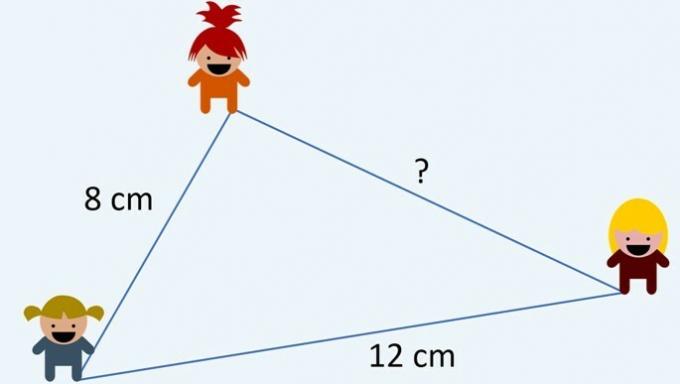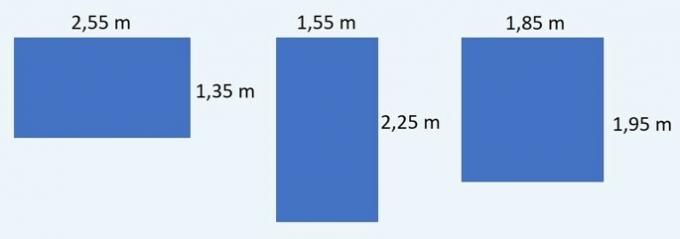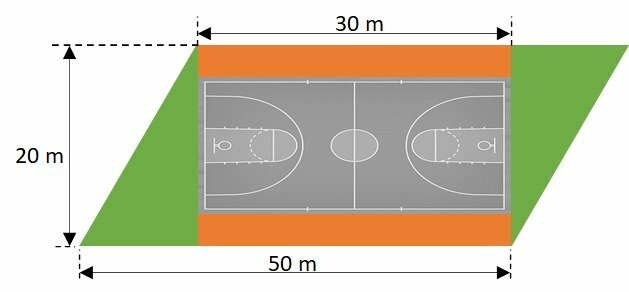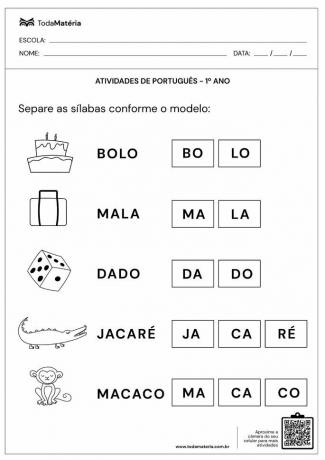In Geometry, area corresponds to the surface measurement, usually calculated by multiplying the base by the height. The perimeter is the result of the sum of the sides of a figure.
Test your knowledge with 10 questions that we created on the topic and clear your doubts with the resolution after feedback.
question 1
Calculate the perimeter of the following flat figures according to the measurements given in each alternative.
a) Square with a 20 cm side.
Correct answer: 80 cm
P = 4.L
P = 4. 20
P = 80 cm
b) Triangle with two sides of 6 cm and one side of 12 cm.
Correct answer: 24 cm
P = 6 + 6 + 12
P = 24 cm
c) Rectangle with 20 cm base and 10 cm high
Correct answer: 60 cm
P = 2(b+h)
P = 2(20 + 10)
P = 2.30
P = 60 cm
d) Diamond with 8 cm on the side.
Correct answer: 32 cm
P = 4.L
P = 4. 8
P = 32 cm
e) Trapezium with base greater than 8 cm, base less than 4 cm and sides of 6 cm.
Correct answer: 24 cm
P = B + b + L1 + L2
P = 8 + 4 + 6 + 6
P = 24 cm
f) Circle with a radius of 5 cm.
Correct answer: 31.4 cm
P = 2 π. r
P = 2 π. 5
P = 10 π
P = 10. 3,14
P = 31.4 cm
question 2
Calculate the area of the flat figures below according to the measurements given in each alternative.
a) Square with a 20 cm side.
Correct answer: A = 400 cm2
A = L2
H = (20 cm)2
H = 400 cm2
b) Triangle with 6 cm base and 12 cm high.
Correct answer: A = 36 cm2
A = b.h/2
A = 6.12/2
A = 72/2
H = 36 cm2
c) Rectangle with 15 cm base and 10 cm high
Correct answer: 150 cm2
A = b.h
A = 15. 10
H = 150 cm2
d) Diamond with a diagonal less than 7 cm and a diagonal greater than 14 cm.
Correct answer: 49 cm2
A = D.d/2
A = 14. 7/2
A = 98/2
H = 49 cm2
e) Trapezium with base less than 4 cm, base greater than 10 cm and height of 8 cm.
Correct answer: 56 cm2
A = (B + b). h/2
A = (10 + 4). 8/2
A = 14. 8/2
A = 112/2
H = 56 cm2
f) Circle with a radius of 12 cm.
Correct answer: 452.16 cm2
A = π. r2
A = π. 122
A = 144.π
A = 144. 3,14
H = 452.16 cm2
question 3
Juliana has two rugs from the same area. The square mat has a side of 4 m and the rectangular mat has a height of 2 m and a base of 8 m. Which mat has the greatest perimeter?
a) The square rug
b) The rectangular mat
c) The perimeters are the same
Correct answer: b) The rectangular mat.
To find out which is the largest perimeter, we must perform the calculation with the values given for the two mats.
Square rug:
P = 4.L
P = 4.4m
P = 16 m
Rectangular rug:
P = 2(b+h)
P = 2(8+2)
P = 2.10
P = 20 m
Therefore, the rectangular mat has the greatest perimeter.
question 4
Carla, Ana and Paula are ready to start a game. Looking at the way they were organized, we can see that their positions form a triangle.
Knowing that the triangle is 30 cm in perimeter and Carla is 8 cm away from Ana and Ana is 12 cm away from Paula, how far is Carla and Paula?

a) 10 cm
b) 11 cm
c) 12 cm
d) 13 cm
Correct answer: a) 10 cm.
A figure's perimeter is the sum of its sides. As the statement gives us the value of the perimeter and two sides of the triangle, we substitute it in the formula and find the distance between Carla and Paula, which corresponds to the third side of the triangle.
P = a + b + c
30 cm = 8 cm + 12 cm + c
30 cm = 20 cm + c
c = 30 cm - 20 cm
c = 10 cm
Therefore, the distance between Carla and Paula is 10 cm.
question 5
Seu João decided to make a fence on his farm in order to plant some vegetables. To prevent the animals from eating his crops, he decided to fence off the area with wire.
Knowing that the part of the land that Seu João used forms a quadrilateral with sides 50 m, 18 m, 42 m and 16 m, how many meters of wire does João need to buy to enclose the land?
a) 121 m
b) 138 m
c) 126 m
d) 134 m
Correct answer: c) 126 m.
If the part of the land chosen for planting vegetables is a quadrilateral with sides 50 m, 18 m, 42 m and 16 m, then the amount of wire used can be calculated by finding the perimeter of the figure, as it corresponds to your contour.
As the perimeter is the sum of the sides of a figure, just add the values given in the question.
P = 50 m + 18 m + 42 m + 16 m
P = 126 m
Therefore, Mr. João needs 126 meters of wire.
question 6
Marcia decided to paint one of the walls of her room a different color. For this, she chose a can of pink paint, whose label says that the content yield is 20 m2.
If the wall that Márcia intends to paint is rectangular, measuring 4 m long and 3 m high, how many paint cans will Márcia need to buy?
a) a can
b) two cans
c) three cans
d) four cans
Correct answer: a) a can.
To know the area to be painted, we must multiply the base by the height.
H = 4 m x 3 m
H = 12 m2
Note that Marcia's wall has an area of 12 m.2 and a can of paint is enough to paint 20 m2, that is, more than she needs.
Therefore, Marcia will only have to buy a can of paint to paint her bedroom wall.
question 7
Laura bought a rectangular piece of fabric and cut 10 equal rectangles with a height of 1.5 m and a base of 2 m. What area is the original part?
a) 15 m2
b) 25 m2
c) 30 m2
d) 40 m2
Correct answer: c) 30 m2.
With the values given in the statement, let's first calculate the area of one of the rectangles formed by Laura.
A = b. H
A = 2 m. 1.5 m
H = 3 m2
Since 10 equal rectangles were made, then the area of the entire piece is 10x the area of a rectangle.
A = 10. 3 m2
H = 30 m2
Therefore, the area of the original part is 30 m.2.
question 8
Pedro is painting the wall of his house, which measures 14.5 m2. Knowing that Peter painted 24 500 cm2 today and intends to leave the rest for tomorrow, what is the area, in square meters, that Pedro has to paint?
a) 10.05 m2
b) 12.05 m2
c) 14.05 m2
d) 16.05 m2
Correct answer: b) 12.05 m2.
To solve this issue we must start by converting the area unit to cm2 for me2.
If 1 meter is 100 cm, then 1 square meter is 100. 100 cm, which is equal to 10 000 cm2. Thus, dividing the area given by 10000 we will find the value in m2.
A = 24 500/10 000 = 2.45 m2
Now, we subtract the painted area from the total area of the wall to find the region that has yet to be painted.
14.5 m2 – 2.45 m2 = 12.05 m2
Thus, it remains for Pedro to paint 12.05 m2 of the wall.
question 9
Lucas decided to sell his car and, to get a buyer quickly, decided to place an ad in the city newspaper. Knowing that R$1.50 per square centimeter of advertising is required, how much did Lucas have to pay for a rectangular advertisement with a base of 5 cm and height of 4 cm?
a) BRL 15.00
b) BRL 10.00
c) BRL 20.00
d) BRL 30.00
Correct answer: d) BRL 30.00.
First, we must calculate the area of the ad created by Lucas.
A = b.h
A = 5 cm. 4 cm
H = 20 cm2
The price paid can be found by multiplying the area by the asking price.
Price = 20. BRL 1.50 = BRL 30.00
Thus, Lucas' ad will cost R$ 30.00.
question 10
Paulo decided to take advantage of the unused space in his bedroom to build a bathroom. Talking to an architect, Paulo discovered that for the room with toilet, sink and shower he would need a minimum area of 3.6 m2.
Respecting the architect's indications, which of the figures below represents the correct plan for Paulo's bathroom?

a) 2.55 m x 1.35 m
b) 1.55 m x 2.25 m
c) 1.85 m x 1.95 m
Correct answer: c) 1.85 m x 1.95 m.
To answer this question, let's calculate the area of the three figures
A = 2.55 x 1.35
A = 3.4425 m2
A = 1.55 x 2.25
A = 3.4875 m2
A = 1.85 x 1.95
A = 3.6075 m2
Therefore, the best choice for Paulo's bathroom is the 1.85 m x 1.95 m option.
read about:
- Area and perimeter
- flat figure area
- Perimeter of flat figures



